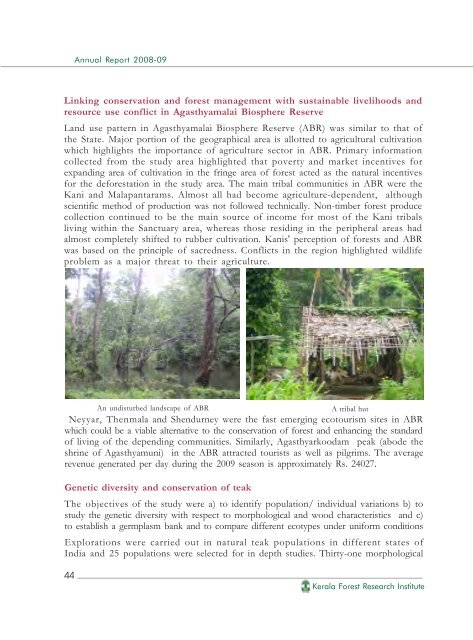2008-'09 - Kerala Forest Research Institute
2008-'09 - Kerala Forest Research Institute
2008-'09 - Kerala Forest Research Institute
Create successful ePaper yourself
Turn your PDF publications into a flip-book with our unique Google optimized e-Paper software.
Annual Report <strong>2008</strong>-09<br />
Linking conservation and forest management with sustainable livelihoods and<br />
resource use conflict in Agasthyamalai Biosphere Reserve<br />
Land use pattern in Agasthyamalai Biosphere Reserve (ABR) was similar to that of<br />
the State. Major portion of the geographical area is allotted to agricultural cultivation<br />
which highlights the importance of agriculture sector in ABR. Primary information<br />
collected from the study area highlighted that poverty and market incentives for<br />
expanding area of cultivation in the fringe area of forest acted as the natural incentives<br />
for the deforestation in the study area. The main tribal communities in ABR were the<br />
Kani and Malapantarams. Almost all had become agriculture-dependent, although<br />
scientific method of production was not followed technically. Non-timber forest produce<br />
collection continued to be the main source of income for most of the Kani tribals<br />
living within the Sanctuary area, whereas those residing in the peripheral areas had<br />
almost completely shifted to rubber cultivation. Kanis' perception of forests and ABR<br />
was based on the principle of sacredness. Conflicts in the region highlighted wildlife<br />
problem as a major threat to their agriculture.<br />
An undisturbed landscape of ABR A tribal hut<br />
Neyyar, Thenmala and Shendurney were the fast emerging ecotourism sites in ABR<br />
which could be a viable alternative to the conservation of forest and enhancing the standard<br />
of living of the depending communities. Similarly, Agasthyarkoodam peak (abode the<br />
shrine of Agasthyamuni) in the ABR attracted tourists as well as pilgrims. The average<br />
revenue generated per day during the 2009 season is approximately Rs. 24027.<br />
Genetic diversity and conservation of teak<br />
The objectives of the study were a) to identify population/ individual variations b) to<br />
study the genetic diversity with respect to morphological and wood characteristics and c)<br />
to establish a germplasm bank and to compare different ecotypes under uniform conditions<br />
Explorations were carried out in natural teak populations in different states of<br />
India and 25 populations were selected for in depth studies. Thirty-one morphological<br />
44<br />
<strong>Kerala</strong> <strong>Forest</strong> <strong>Research</strong> <strong>Institute</strong>

















